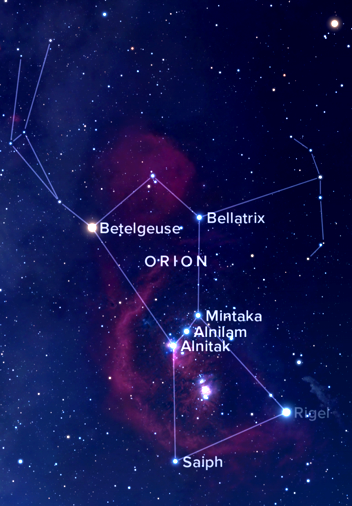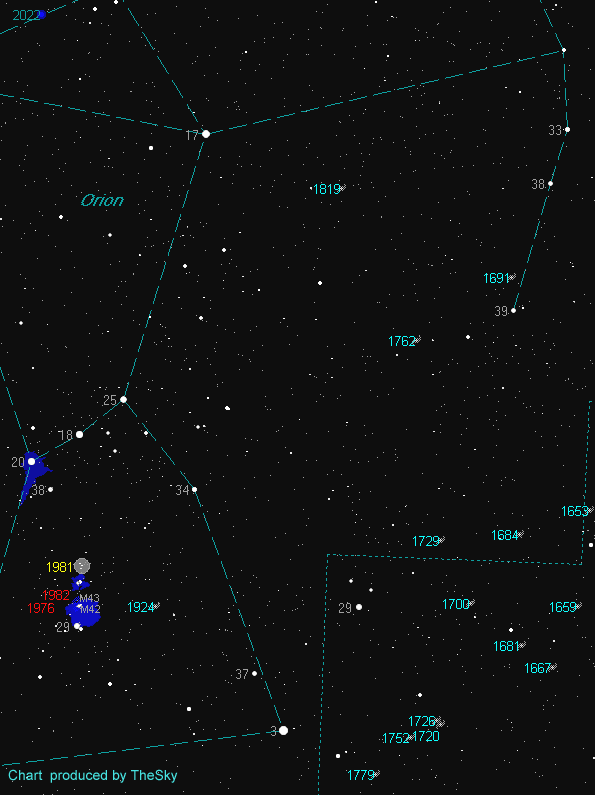Iconic Orion
I am sure some of you have received or bought your first pair of binoculars or telescope for Christmas. Although not essential to enjoy the night sky, they do allow you to locate and enjoy those hard to see objects. Teamed with a good set of star charts and a red filtered flashlight, one can learn the constellations and more so the brighter objects what adore the night sky. Although binoculars are portable, they do not deliver the higher magnification as does a telescope but they are invaluable to hunting elusive targets that are just past the visual limitations of the human eye. No matter what is your instrument of choice, you are on your way to many years of astronomical enjoyment.
And what better constellation to open the New Year than with Orion the Hunter. Depicted in mythology as he fights off Taurus the Bull (to the upper right), the hunter is also accompanied by his two dogs, Canis Major and Canis Minor. As the famous three stars of his belt rest near the celestial equator, Orion can be viewed and enjoyed from both hemispheres. The jewel of this featured constellation lies in the sword of his belt. Catalogued as NGC 1976 and more commonly as M42, the Orion Nebula is an awe-inspiring object what can be seen even with the naked eye. This ghostly looking cloud is called an emission nebula and the place stars are slowly developing to one day shine like the others. The entire cloud is estimated to be some 42 light-years and 1,500 light-years away. Hundreds of suns will be born from this stellar nursery.

Many of the brighter stars of any constellation have proper names. The 165 Arabic names give a sense of personality to a particular star rather than a long, scientific catalogue number. Orion is no acceptation as the belt stars from left to right are named Alnitak, Alnilam and Mintaka. Other than a gorgeous line-up of three bright suns, the trio was used in the positioning of the great pyramids in Giza some 4,500 years ago.
Alnitak is a magnitude 1.7 brilliant spectral class1 O9 star and is 800 light-years from us. It is a hot blue supergiant star with a visual luminosity of 10,000 times that of our Sun but since this star radiates mostly in the ultraviolet that we can not see, luminosity moves up to 100,000 times the Sun. At 1,350 light away the second star of the belt - Alnilam is also a magnitude 1.7 star and is a class B0 supergiant and even more luminous than Alnitak. With solar winds racing off the surface at 2,000 km/sec and with a surface temperature of 25,000 K, this mega furnace with a luminosity 375,000 times our Sun. Last but not least is Mintaka to the far right. A bit dimmer at magnitude 2.2, Mintaka shines with a luminosity of 90,000 times that of our Sun and is a multiple star system.
Before moving away from the belt, go back to Alnitak for a moment. To the upper left and very close to the star is an area of gas and dust commonly known as the Flame Nebula. NGC 2024 is actually a combination of the star-forming emission component along with the reflection aspect of the nebula. The region is lit up from Alnitak which shines energetic ultraviolet light into the nebula thus causing electrons to be knocked around. The estimated distance of the Flame ranges from 1,000 to 1,500 light-years away which puts Alnitak between NGC 2014 and us.

Winter is not especially known as galaxy season but a few can be found in every constellation. Although Orion is home to only five galaxies at 13th magnitude, more appear in the constellation Eridanus but back to Orion. NGC 1819 is a magnitude 12.5 barred spiral galaxy located 200 million light-years away. This galaxy is three and a half degrees west of the star Bellatrix, hunter’s top right shoulder. From this object, proceed a little more than four degrees southwest till you find NGC 1762. This is a magnitude 12.7 spiral galaxy located a quarter of a billion light-years away.
As predicted, Comet Lovejoy (C2014 Q2) is now a naked eye treat in southern skies and rapidly moving from night to night. Towards the end of 2014, it came into view at 5th magnitude in the constellation Lepus and is on a northwest trek. In January the comet will move through Eridanus, Taurus, Aries and Triangulum. Lovejoy will swing past the Earth on January 7 at a close 70 million kilometres and is closest to the Sun on January 30 at 193 million kilometres. Even with the moonlight, this is an easy target in binoculars. Being the brightest comet in years, you must check it out and photograph it is you can. Even a DSLR camera and a telephoto lens on a tripod, a 5-second exposure at ISO 1600 will show a green dot. As of January 1, the comet is moving at 36 km/sec.
The main meteor shower of this month belongs to the Quadrantids which peaks on the night of January 3-4. On the heels of last month’s Geminids, this display also boasts an hourly rate of 120 meteors per hour but yes the good old full Wolf moon on the 4th at 22:52 eastern time will reduce the numbers for sure.
2014 closed with news of a supernova in the sky. Located in the constellation Virgo, galaxy NGC 4666 now shows a magnitude 14 dot close to its nucleus. It was discovered on December 9 by the Automated Sky Survey for SuperNovae (ASAS-SN). The magnitude 10.8 barred spiral galaxy is about 59 million light-years from Earth. Here is the finder chart for the supernova.
The planet Jupiter still dominates the night sky. It rises at 8 p.m. local time and stays up all night long. Because of Jupiter’s tilt on its axis, the four main Galilean moons we see each and every night we point our telescope to them, now are in the perfect angular position to eclipse each other. In some cases, these events only past a few minutes but are amazing to watch first hand. For instance, coming up on Jan 3 at 5:55 a.m. eastern time when Europa partially occults Io for eleven minutes. On January 19 Ganymede occults Europa for only 5 minutes at 9:31 p.m. eastern. This same event occurs again on January 26 at 00:12 a.m. eastern. Even more dramatic but not as rare are the double shadow events on the Jovian surface on the 16th at 10:51 p.m. For more double transit notices, check out page 99 of the Observer’s Handbook 2015 and for all other events refer to page 231.
This month’s new moon (lunation 1139) occurs on the 20th at 8:14 a.m. eastern
Until next month, clear skies everyone.
Twitter: @astroeducator
1 original link was https://upload.wikimedia.org/wikipedia/commons/1/17/Hertzsprung-Russel_StarData.png
